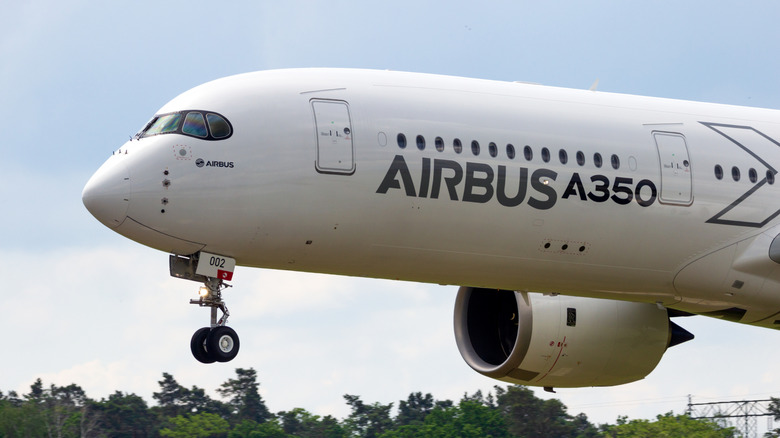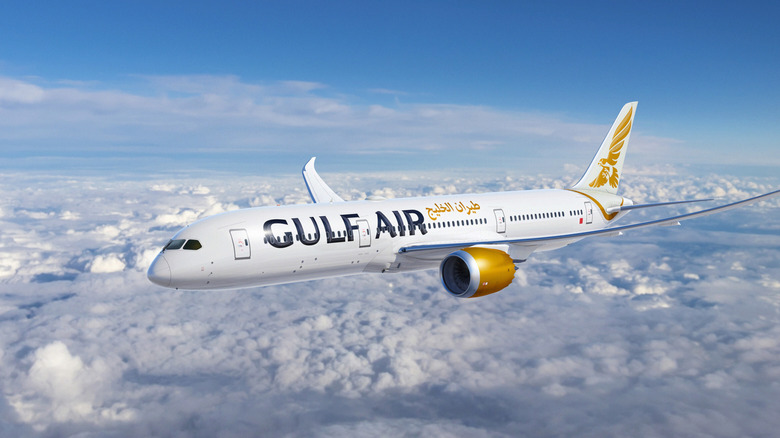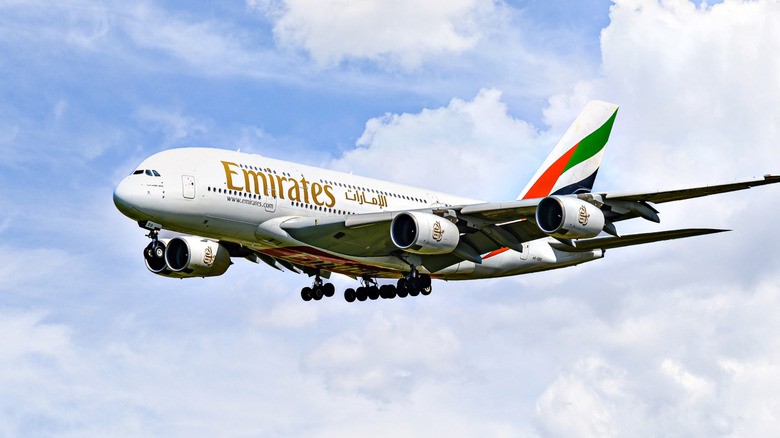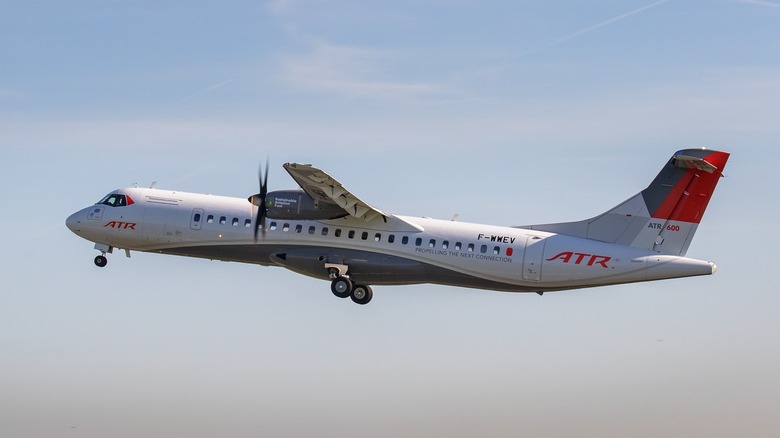5 Of The Biggest Aircraft Manufacturers In The World
A small handful of companies are responsible for building virtually all of the world's commercial aircraft, with the two largest players making up around 80% of the current global fleet. These two big players are Boeing and Airbus, and whether you're boarding a flight to travel across the country or to travel between continents, there's a good chance you'll be flying on an aircraft from either manufacturer. However, despite taking the lion's share of new plane orders, they're far from the only manufacturers that commercial airlines rely on to keep shuttling passengers across the globe.
According to 2025 data from IATA, around 92% of the current global commercial active fleet is made by one of five companies, making each of them one of the biggest aircraft manufacturers in the world. Each of the fleet figures here only concerns commercial aircraft — other sectors like defense and personal aircraft are not accounted for in the data.
Boeing
Despite its well-documented troubles, Boeing still has the largest share of active commercial aircraft according to IATA data, with 40% of the global fleet. The company was founded in 1916 and originally made aircraft for the U.S. Navy before expanding into the manufacture of civilian aircraft. Over the decades, Boeing has been responsible for making some of the world's most recognisable aircraft, counting icons like the 747 and 787 Dreamliner among its best jets.
In recent years, the company has been hit by a string of scandals. Its 737 MAX aircraft has suffered from multiple high-profile issues, which allegedly arose from the manufacturer's rush to get the model to market. In 2018 and 2019, two 737 MAX aircraft were involved in fatal crashes, with regulators grounding the model for over a year following the second crash. In 2024, a panel covering an emergency exit detached from an Alaska Airlines 737 Max while it was in flight, leading to another temporary grounding.
The company has been hit with other issues in 2025, including a strike that primarily affected its defense aircraft production. However, its order books still remain healthy, and it has ramped up its delivery rate over the course of the year, with 2025 set to see Boeing's highest annual aircraft delivery total since 2018.
Airbus
Boeing's longstanding European rival, Airbus, was first formed in 1970. Today, it's the second largest aircraft manufacturer in the world in terms of its global commercial active fleet, with 39% of commercial planes in the skies being built by Airbus. Its first commercial aircraft was the A300, and over 200 of them are thought to remain in service. However, they're mostly either operating as freighters or operating in countries where sanctions prevent newer planes from flying.
Airbus' modern fleet consists of five families: the A220, A320, A330, A350, and A380. While Airbus no longer produces the A380, it remains a key part of fleets for airlines like Emirates, as well as being a favorite among avgeeks. Emirates CEO Tim Clark spoke to Business Insider in early 2025 and said that he'd be interested in purchasing more examples of the A380, particularly since the latest developments in engine technology could make them significantly more efficient. However, Airbus bosses have largely dismissed the idea of restarting production.
The company already has a huge backlog of orders for its other models, with a total of 8,665 unfulfilled orders for its commercial aircraft as of September 2025. That's a significantly higher backlog than its rival Boeing, which had 5,911 orders on its books in November 2025.
Embraer
While Airbus and Boeing dominate the commercial aircraft market, Embraer is the third largest manufacturer, with around 7% of the global commercial active fleet according to IATA. Embraer's story is an unlikely one, having originally been formed by the Brazilian government in 1969. When its smaller aircraft, such as the 120, became popular with international buyers in the '80s, Embraer transitioned into private ownership and continued investing in the development of a larger range of aircraft.
Embraer's current lineup includes regional jets and small narrowbody jets, including its E-Jet family and ERJ family. Rather than looking to increase the size of its jets to directly rival aircraft made by Airbus and Boeing, Embraer has stated that it's looking to sell a larger number of smaller jets to wealthy regions where inter-city connectivity is limited. In particular, it has highlighted the Middle East as a big part of its future plans, noting that many major cities in the region don't have frequent connections. Attracting buyers in the area could help bolster its order books, further securing its spot as the third-largest commercial plane maker.
ATR
With around 3% of the global commercial active fleet according to IATA data, ATR is the fourth-largest aircraft manufacturer. The company was first formed in 1981 and today operates as a joint venture between Airbus and defense giant Leonardo. ATR builds the 42 and 72 turboprop regional aircraft, which can operate in a wide variety of terrains and feature lower operating costs to make shorter and less in-demand routes economically viable.
The ATR 72 turboprop has been in production since the '80s, and is offered both as a freighter and as a passenger plane. The ATR 72-600 can carry up to 78 passengers, while its smaller stablemate, the ATR 42-600, seats up to 50 passengers. Buoyed by a mix of orders from new and existing customers, ATR saw a 40% boost in aircraft sales in 2024 compared to 2023, and had an order backlog of around 150 aircraft at the start of 2025. In its latest report, the company said that Canadian airlines made up a notable proportion of new order interest, but it did not individually name any of the interested airlines.
Bombardier
Rounding out the top five is Bombardier, which IATA says manufactured around 3% of the global commercial active fleet. Bombardier is well known as one of the biggest private jet makers — it even makes 2025's fastest private jet, which nearly breaks the speed of sound. The company was founded in Quebec, Canada, initially rising to prominence in 1937 as the maker of the B7 snowmobile. The company unveiled the Ski-Doo in 1959, and in 1970, it acquired an Austria-based tram manufacturer, marking its first foray into the railway industry. It wasn't until 1986 that Bombardier entered the aviation industry by purchasing Canadair, a business jet manufacturer.
In 2008, Bombardier expanded from business jet production to commercial aircraft production, launching the C Series. It was a big gamble for the company, but it didn't pay off. The Quebec government provided over $1 billion CAD of investment to help stem the losses from Bombardier's commercial jet division, but orders didn't pick up quickly enough, and the company was forced to sell a controlling stake in the venture to Airbus in 2018. Two years later, Airbus bought the remaining stake, rebranding the aircraft as the A220.
Bombardier also previously manufactured the Q400 turboprop and the CRJ regional jet, but sold those divisions off to Longview Aviation and Mitsubishi, respectively. It has now returned to making business jets, with no plans to return to building commercial jets. However, throughout its brief venture, it produced enough commercial aircraft to still be considered the fifth largest manufacturer in global fleet terms.





